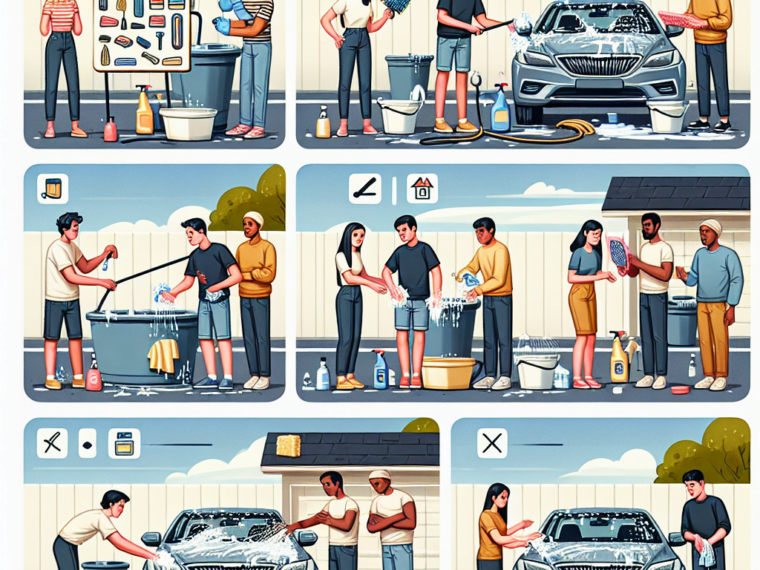I. Introduction
When it comes to taking care of your car, regular washing and maintenance are crucial. Not only does it keep your vehicle looking good, but it also plays a significant role in preserving its condition and value. By adhering to a consistent car care routine, you can ensure that your car remains in top shape for years to come.
Importance of Car Washing and Maintenance
Car washing and maintenance are essential for preserving the exterior and interior of your vehicle. Regular washing helps to remove dirt, grime, and other contaminants that can damage the paint and finish of your car. Maintenance tasks such as oil changes, tire rotations, and fluid checks are vital for keeping your car running smoothly and efficiently.
Benefits of Regular Car Care
Engaging in regular car care offers numerous benefits. It enhances the appearance of your car and protects it from rust, corrosion, and other forms of damage. Additionally, maintaining your car can prevent costly repairs in the long run and ensure that it operates at its best performance.
II. The Basics of Car Washing
When it comes to maintaining your car, proper washing is essential. Choosing the right car wash products is the first step in ensuring a thorough and effective clean. Look for gentle, pH-balanced car wash soaps and avoid using household detergents which can strip the paint and leave residue. Additionally, investing in a high-quality microfiber wash mitt and soft drying towels can help prevent scratches and swirl marks on the paint.
Proper techniques for washing a car
Using the two-bucket method is a recommended technique for washing a car. Fill one bucket with soapy water and the other with clean water. Dip the wash mitt into the soapy water, wash a section of the car, then rinse the mitt in the clean water before reapplying soap. This helps prevent dirt and grit from being transferred back onto the car’s surface, reducing the risk of scratches. Work from the top down, washing and rinsing one section at a time to ensure a thorough clean.
Tips for drying and detailing
After washing, it’s important to dry the car thoroughly to prevent water spots. Use a soft, absorbent drying towel and gently pat the surface dry, avoiding any rubbing motions that could cause swirl marks. Once the car is dry, consider detailing the exterior with a high-quality carnauba wax or synthetic sealant to protect the paint and enhance its shine. Pay attention to areas like the wheels, trim, and glass to ensure a complete and polished finish.
III. Advanced Car Washing Techniques
When it comes to advanced car washing techniques, it’s important to understand the different types of car washes available. Whether you opt for a touchless, self-serve, or automatic car wash, each method has its own benefits and drawbacks. Additionally, DIY car washing methods can be a cost-effective and personalized way to keep your vehicle clean. From using the two-bucket method to employing foam cannons, there are various techniques to explore. Furthermore, waterless car washing options provide an eco-friendly and convenient alternative, especially in areas with water restrictions. By understanding and utilizing these advanced car washing techniques, you can ensure that your vehicle remains clean and well-maintained.
IV. Maintaining the Exterior
When it comes to keeping your car’s exterior in top condition, waxing and polishing play a crucial role. These processes not only enhance the vehicle’s appearance but also provide a protective layer against environmental elements. Regular waxing and polishing can help maintain the paint and clear coat, preventing them from fading or deteriorating over time.
Importance of waxing and polishing
Waxing and polishing are essential for preserving the shine and luster of your car’s paint. By creating a barrier against UV rays, dirt, and other contaminants, these treatments help to maintain the overall appearance of the vehicle. Furthermore, they can also minimize the appearance of minor scratches and swirl marks, keeping the paintwork looking pristine.
Protecting the paint and clear coat
By regularly waxing and polishing your car, you can safeguard the paint and clear coat from damage caused by exposure to the elements. This protective layer acts as a shield, preventing oxidation, rust, and corrosion from affecting the exterior surfaces. Additionally, it helps to repel water and prevent the accumulation of dirt and grime, making it easier to maintain a clean and polished finish.
Dealing with stubborn stains and contaminants
In some cases, stubborn stains and contaminants may mar the appearance of your car’s exterior. To address this issue, it’s important to use specialized products and techniques to remove these blemishes without causing damage to the paint or clear coat. By employing gentle yet effective cleaning methods, you can restore the pristine look of your vehicle and maintain its overall aesthetic appeal.
V. Interior Care and Maintenance
When it comes to maintaining the interior of your car, there are several key areas to focus on.
Cleaning the interior surfaces
Regular cleaning of the interior surfaces is essential to keep your car looking and feeling fresh. Use a gentle, non-abrasive cleaner to wipe down the dashboard, console, and other hard surfaces. For leather seats, use a specialized leather cleaner to maintain their appearance and prevent cracking.
Protecting upholstery and trim
To protect the upholstery and trim from wear and tear, consider using a fabric protector or upholstery sealant. These products can help repel stains and spills, keeping your interior looking new for longer.
Deodorizing and freshening the interior
To keep your car smelling fresh, use a car-specific air freshener or deodorizer. Regularly clean out any trash or debris, and consider using a fabric refresher to eliminate odors from upholstery and carpeting.
VI. Engine and Mechanical Maintenance
Regular engine cleaning is essential for the proper functioning and longevity of your vehicle. Over time, dirt, grime, and debris can build up in the engine compartment, leading to overheating and potential damage. By regularly cleaning the engine, you can prevent these issues and ensure that your car runs smoothly.
Importance of regular engine cleaning
Regular engine cleaning is crucial for maintaining the overall performance and efficiency of your vehicle. It helps to remove dirt, grease, and other contaminants that can accumulate in the engine compartment, which can hinder the proper functioning of various components. Additionally, a clean engine is easier to inspect for any signs of leaks or damage, allowing for timely maintenance and repairs.
Checking and topping up fluids
Checking and topping up fluids such as engine oil, coolant, brake fluid, and transmission fluid is a vital part of engine maintenance. Proper fluid levels are essential for the smooth operation of the engine and other mechanical components. Regularly inspecting and replenishing these fluids as needed can help prevent potential issues and ensure the longevity of your vehicle.
Tips for maintaining the engine and mechanical components
Aside from regular cleaning and fluid checks, there are additional tips for maintaining the engine and mechanical components of your car. This includes following the manufacturer’s recommended maintenance schedule, replacing air filters as needed, and ensuring that the drive belts and hoses are in good condition. Additionally, it’s important to address any unusual noises, vibrations, or warning lights promptly to prevent further damage and costly repairs.
VII. Troubleshooting Common Issues
Water spots and streaks can be a common issue after washing your car. To address this problem, try using a solution of equal parts water and vinegar to gently wipe away the spots and streaks. Alternatively, a commercial water spot remover can also be effective in eliminating these blemishes. After removing the spots, be sure to thoroughly dry the car to prevent new water spots from forming.
Addressing Paint Swirls and Scratches
If you notice paint swirls or scratches on your car’s surface, it’s important to address them promptly to prevent further damage. Begin by washing the affected area with a mild car wash soap and water. Then, use a scratch removal product or a polishing compound to carefully buff out the imperfections. For deeper scratches, it may be necessary to seek professional assistance from a car detailing service.
Handling Other Common Car Washing and Maintenance Problems
There are various other common car washing and maintenance problems that may arise, such as bird droppings, tree sap, or tar spots. To tackle these issues, consider using specialized cleaning products designed to remove these specific contaminants without damaging the car’s paint. Additionally, regular waxing and polishing can help protect the car’s exterior and minimize the occurrence of these problems in the future.
VIII. Environmental Considerations
When it comes to car washing and maintenance, it’s important to consider the environmental impact of our actions. There are several eco-friendly car washing options available that can help minimize the use of water and reduce the introduction of harmful chemicals into the environment. Additionally, it’s crucial to properly dispose of car care products such as soaps, waxes, and polishes to prevent them from contaminating water sources or harming wildlife. Minimizing environmental impact while maintaining a car involves using biodegradable and non-toxic cleaning products, as well as avoiding excessive water usage. By being mindful of these factors, car owners can contribute to the preservation of the environment while keeping their vehicles in top condition.
The Ultimate Guide To Washing Your Car
The correct order to wash a car is to start by rinsing the car with water to remove loose dirt and contaminants. Then, use a car wash soap to clean the vehicle from top to bottom, followed by rinsing it again and drying it with a microfiber cloth to prevent water spots.
How do I clean my car like a professional?
To clean your car like a professional, use the two-bucket method, high-quality car wash soap, and microfiber cloths. Additionally, pay attention to the details, such as cleaning the wheels, tires, and interior surfaces, to achieve a professional-looking result.
How do you build a successful car wash?
To build a successful car wash, focus on providing excellent customer service, using high-quality cleaning products, and creating a welcoming and efficient environment for your customers. Additionally, effective marketing and advertising can help attract more customers to your car wash.
How do you wash your car effectively?
To wash your car effectively, use the two-bucket method, high-quality car wash soap, and microfiber cloths. Ensure thorough rinsing and drying to achieve a clean and shiny finish.
What is the 2 bucket method of washing a car?
The 2 bucket method involves using one bucket with soapy water for washing the car and another bucket with clean water for rinsing the wash mitt or sponge. This method helps prevent dirt and contaminants from being reintroduced to the car’s paintwork, resulting in a safer and more effective cleaning process.
Is it better to hand wash your car or car wash?
Hand washing your car is generally better than using automatic car washes as it allows for more control over the cleaning process and reduces the risk of potential damage to the vehicle’s paintwork. Hand washing also provides an opportunity to pay attention to detail and preserve the car’s appearance.
Why do cars run better after car wash?
Cars may appear to run better after a car wash due to the removal of dirt and contaminants from the exterior surfaces, including the engine bay and undercarriage. While a car wash does not directly improve the performance of the vehicle, a clean car can give the impression of improved performance and value.
How often should I wash my car?
The frequency of car washing depends on various factors such as the driving conditions, weather, and personal preferences. However, a general guideline is to wash your car every 2-4 weeks to maintain its appearance and protect the paintwork from contaminants and environmental hazards.
What are the weaknesses of a car wash business?
The weaknesses of a car wash business may include high water usage, potential environmental impact, competition from other car wash services, and the need for continuous maintenance and equipment upgrades. Additionally, seasonal variations in demand and weather can affect the profitability of a car wash business.
What kind of soap do you use to wash a car?
When washing a car, it is recommended to use a high-quality car wash soap specifically designed for automotive use. Avoid using household detergents or soaps, as they can strip the wax and protective coatings from the car’s paint, potentially causing damage.



